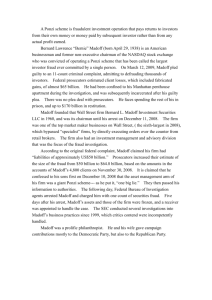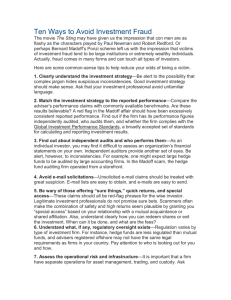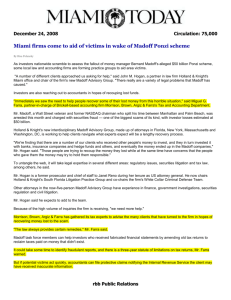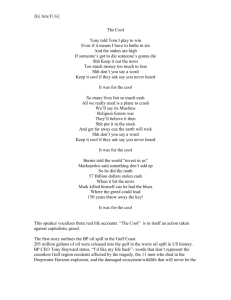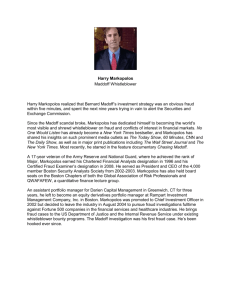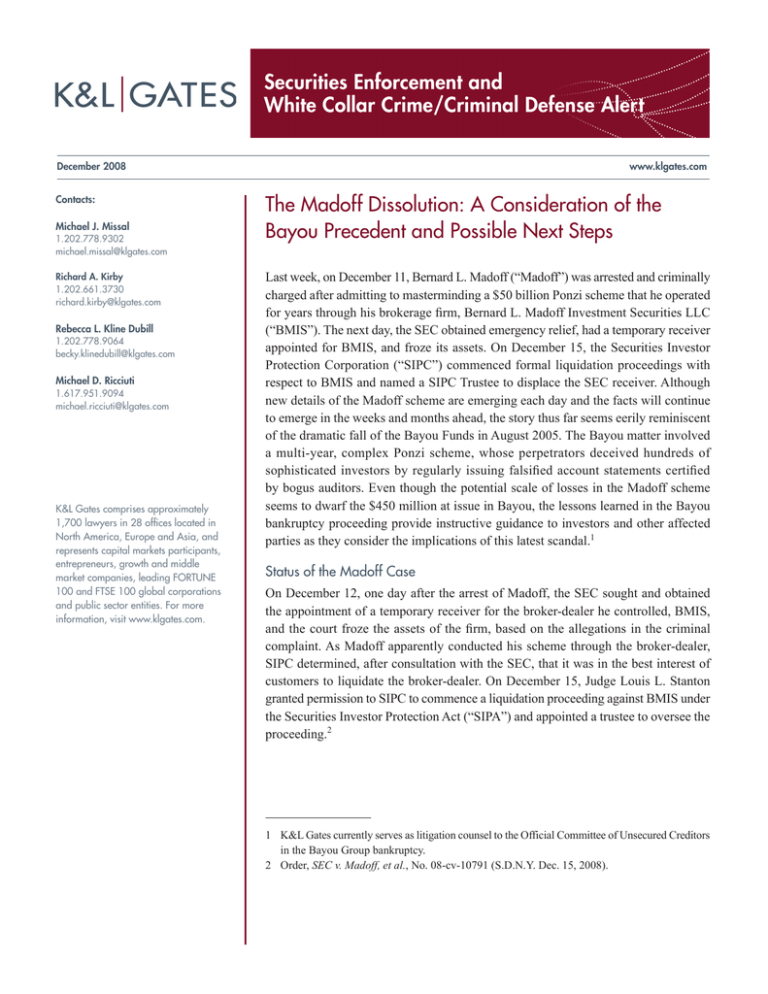
Securities Enforcement and
White Collar Crime/Criminal Defense Alert
December 2008
Contacts:
Michael J. Missal
1.202.778.9302
michael.missal@klgates.com
Richard A. Kirby
1.202.661.3730
richard.kirby@klgates.com
Rebecca L. Kline Dubill
1.202.778.9064
becky.klinedubill@klgates.com
Michael D. Ricciuti
1.617.951.9094
michael.ricciuti@klgates.com
K&L Gates comprises approximately
1,700 lawyers in 28 offices located in
North America, Europe and Asia, and
represents capital markets participants,
entrepreneurs, growth and middle
market companies, leading FORTUNE
100 and FTSE 100 global corporations
and public sector entities. For more
information, visit www.klgates.com.
www.klgates.com
The Madoff Dissolution: A Consideration of the
Bayou Precedent and Possible Next Steps
Last week, on December 11, Bernard L. Madoff (“Madoff”) was arrested and criminally
charged after admitting to masterminding a $50 billion Ponzi scheme that he operated
for years through his brokerage firm, Bernard L. Madoff Investment Securities LLC
(“BMIS”). The next day, the SEC obtained emergency relief, had a temporary receiver
appointed for BMIS, and froze its assets. On December 15, the Securities Investor
Protection Corporation (“SIPC”) commenced formal liquidation proceedings with
respect to BMIS and named a SIPC Trustee to displace the SEC receiver. Although
new details of the Madoff scheme are emerging each day and the facts will continue
to emerge in the weeks and months ahead, the story thus far seems eerily reminiscent
of the dramatic fall of the Bayou Funds in August 2005. The Bayou matter involved
a multi-year, complex Ponzi scheme, whose perpetrators deceived hundreds of
sophisticated investors by regularly issuing falsified account statements certified
by bogus auditors. Even though the potential scale of losses in the Madoff scheme
seems to dwarf the $450 million at issue in Bayou, the lessons learned in the Bayou
bankruptcy proceeding provide instructive guidance to investors and other affected
parties as they consider the implications of this latest scandal.1
Status of the Madoff Case
On December 12, one day after the arrest of Madoff, the SEC sought and obtained
the appointment of a temporary receiver for the broker-dealer he controlled, BMIS,
and the court froze the assets of the firm, based on the allegations in the criminal
complaint. As Madoff apparently conducted his scheme through the broker-dealer,
SIPC determined, after consultation with the SEC, that it was in the best interest of
customers to liquidate the broker-dealer. On December 15, Judge Louis L. Stanton
granted permission to SIPC to commence a liquidation proceeding against BMIS under
the Securities Investor Protection Act (“SIPA”) and appointed a trustee to oversee the
proceeding.2
1 K&L Gates currently serves as litigation counsel to the Official Committee of Unsecured Creditors
in the Bayou Group bankruptcy.
2 Order, SEC v. Madoff, et al., No. 08-cv-10791 (S.D.N.Y. Dec. 15, 2008).
Securities Enforcement and
White Collar Crime/Criminal Defense Alert
A SIPA liquidation proceeding is a specialized form
of liquidation for broker-dealers through which
securities and other assets owned by customers of the
defunct broker-dealer are transferred to other firms
if possible, customer property is distributed ratably
to customers, and the broker-dealer is liquidated for
the benefit of customers.3 In addition, SIPC may
provide customers of BMIS with protection for
losses of customer property up to $500,000.4 The
case will be administered by the bankruptcy court
for the Southern District of New York and ordinary
bankruptcy law will govern the proceedings to
the extent it is consistent with SIPA. With certain
limited exceptions, all other actions by investors
to recover assets from BMIS, including recently
filed class actions, will be stayed.5 Claims against
Madoff personally and other third parties related
to this scheme are not stayed, but will likely be
consolidated before Judge Stanton.
Unfortunately, however, SIPC protection may not
provide substantial recovery for most investors.
To the extent losses were suffered by clients of
Madoff outside of BMIS customer accounts, SIPC
does not offer protection. Moreover, if the brokerdealer’s records are inaccurate, as is often the case
with a Ponzi scheme, it may not be possible for
SIPC to determine share ownership and individual
account holdings, as SIPC noted in its press release
announcing commencement of the liquidation
proceedings.6
3 15 U.S.C. § 78aaa et seq.; see also SIPC Press Release,
12/15/08, available at: http://www.sipc.org/media/
release15Dec08.cfm. Although the exact structure of the
firm remains unclear, Madoff apparently operated as a
broker-dealer with an investment management segment.
4 15 U.S.C. § 78fff(a)(1)(B).
5 11 U.S.C. § 362(a). Section 362(b) provides for certain
exceptions to the automatic stay, including the right
of counter parties to terminate or accelerate securities
contracts.
6 SIPC Press Release, 12/15/08, available at: http://www.
sipc.org/media/release15Dec08.cfm.
Recovery of the Estate’s Assets
The SIPC Trustee’s first order of business will be to
identify and recover any remaining estate assets. As
with most Ponzi schemes, however, the principals
likely already have dissipated most of the tangible
assets of the estate by the time of the collapse. If
that is true here, the focus of the trustee likely will
turn to recovering assets through claims against
third parties.
As required by SIPA, the SIPC Trustee will initiate
a claims process for which each customer of
BMIS will have an opportunity to submit claims.
The SIPC Trustee will manage the claims process
and distribute pro rata the customer property as
quickly as possible. The balance of any estate assets,
including any recoveries from third parties, will not
likely be distributed for some years.
Fraudulent Transfer Claims Against Early
Redeemers
In the Bayou matter, most of the assets that were
recovered were obtained through the pursuit of
fraudulent transfer claims against investors that
had redeemed some or all of their money prior to
the commencement of the bankruptcy proceeding.
Both the Bankruptcy Code and New York state law,
which applied to the Bayou proceeding, provide that
a transfer made with actual or constructive intent
to hinder, delay or defraud creditors is a fraudulent
transfer that can be rescinded.7 A number of courts
have held that each individual redemption payment
is presumptively a fraudulent transfer intended to
actually hinder, delay or defraud other investors and
may be rescinded by creditors or a trustee.8 Under
7 11 U.S.C. §§ 548(a) and 544; N.Y. Debt. & Cred.
§ 273-76.
8 See, e.g., Terry v. June, 432 F. Supp. 2d 635, 639
(W.D. Va. 2006); Jobin v. Lalan (In re M & L
Business Machine Co., Inc.), 160 B.R. 851, 857
(Bankr. D. Colo. 1993), aff’d, 167 B.R. 219 (1994)
(“[I]n a Ponzi scheme the only inference that a
court can make is that the Debtor had the requisite
intent to hinder, delay or defraud under § 548(a)
(1).”); Merrill v. Abbott (In re Independent Clearing
House), 77 B.R. 843, 860 (D. Utah 1987).
December 2008 | 2
Securities Enforcement and
White Collar Crime/Criminal Defense Alert
the Bankruptcy Code, the reach-back provision is
two years from the date of commencement of the
liquidation proceeding. The reach-back period under
New York law is six years.9
Moreover, fraudulent transfer claims can seek to
claw back both redeemed false profit and principal.
An investor may defeat a fraudulent transfer claim
by affirmatively showing that it redeemed in good
faith and for value.10
In 2006, Bayou’s court-appointed receiver brought
over 130 fraudulent transfer adversary proceedings
against Bayou investors that had redeemed fictitious
profit and principal within two years of Bayou’s
bankruptcy filing. Later in 2008, the Bayou receiver
brought New York state law claims against persons
redeeming up to six years before the bankruptcy
filing. In a series of rulings, the court held that
redemption payments from a Ponzi scheme
presumptively satisfied the “actual fraud” prong of
the fraudulent transfer standard and that the “good
faith” affirmative defense requires an objective
test of whether a reasonable and prudent investor
should have been on inquiry notice of the fraud,
and, if on inquiry notice, the redeemer was diligent
in its investigation.11 In addition, the court ruled as a
matter of law that redemption payments received by
investors in excess of their original principal based
on artificially inflated results, or so-called “fictitious
profits,” were required to be refunded to the estate,
regardless of the redeemer’s good faith.12 Moreover,
the court held that a redeeming investor cannot
utilize the good faith affirmative defense unless it
9 11 U.S.C. § 548(a)(1) (two-year statute of limitations
from time of filing); N.Y. C.P.L.R. § 213 (six-year statute
of limitations for actions based on fraud).
1011 U.S.C. § 548(c) (transferees have an affirmative
defense to the extent they took for value and in good
faith); N.Y. Debt. & Cred. § 272 (same).
11 In re Bayou Group, LLC, 362 B.R. 624 (Bankr. S.D.N.Y.
2007); In re Bayou Group, LLC, 396 B.R. 810, *__
(Bankr. S.D.N.Y. 2008) (available, at this writing, only
on Westlaw and not on Lexis).
12 362 B.R. at 631-36.
can show it conducted a diligent investigation of
each potential problem or red flag.13
As a result of these rulings, all of the investors in
the Bayou matter who redeemed their investments
within the six-year clawback period were ordered
to return fictitious profits and may be required to
pay pre-judgment interest on those profits. Over
90 redeemers have settled with the estate for the
return of false profits and a portion of their principal.
In addition, the court has ordered several dozen
investors to refund all of their principal. The court
upheld the good faith defenses of a small number
of redeemers, and ordered trial of a handful more
cases. To date, the Bayou receiver has recovered
through settlement and legal rulings approximately
$68 million, with an anticipated litigation recovery
for creditors of the Bayou estate, net of expenses, of
between 15 and 20 cents per dollar.
Claims Against Third Parties
Claims against third parties, including financial
advisors, auditors, financial counter parties, or other
persons, are another potential source of recovery.
The SIPC Trustee will be severely constrained
from pursuing those claims on behalf of the estate
because of legal defenses available to those third
parties. While it is possible that pending class
actions 14 may provide an alternative source of
recovery to individual investors for certain types
of claims, Ponzi schemes like Madoff’s may be
particularly unsuitable to class treatment where
the circumstances of each individual investor’s
recruitment and conduct may be different.
13 396 B.R. at *20-26.
14See, e.g., Kellner v. Madoff, No. 08-cv-5026 (E.D.N.Y.
Dec. 12, 2008).
December 2008 | 3
Securities Enforcement and
White Collar Crime/Criminal Defense Alert
Next Steps for Those Impacted by the
Madoff Events
As the news regarding the Madoff scheme unfolds,
those impacted by the Madoff fraud should take
prompt steps to investigate the circumstances
surrounding their investments in Madoff’s investment
vehicles and evaluate their own exposure to claims.
Preservation of records is crucial and should be
undertaken immediately. Further, anyone affected
by the Madoff fraud should promptly review their
insurance policies to determine the scope of their
coverage, and whether the policies require notice of
possible claims. Finally, as many facts regarding the
Madoff scheme are unknown at this time, and given
potential liabilities, all parties should be extremely
cautious about making any public statements, or
selectively providing information, regarding the
extent of their connection to, knowledge of, and
investments in the Madoff enterprise in order to
avoid increasing their exposure.
For more information, please contact:
Michael J. Missal
1.202.778.9302
michael.missal@klgates.com
Richard A. Kirby
1.202.661.3730
richard.kirby@klgates.com
Rebecca L. Kline Dubill
1.202.778.9064
becky.klinedubill@klgates.com
Michael D. Ricciuti
1.617.951.9094
michael.ricciuti@klgates.com
K&L Gates comprises approximately 1,700 lawyers in 28 offices located in North America, Europe and Asia, and represents capital markets
participants, entrepreneurs, growth and middle market companies, leading FORTUNE 100 and FTSE 100 global corporations and public sector
entities. For more information, visit www.klgates.com.
K&L Gates comprises multiple affiliated partnerships: a limited liability partnership with the full name K&L Gates LLP qualified in Delaware and
maintaining offices throughout the U.S., in Berlin, in Beijing (K&L Gates LLP Beijing Representative Office), and in Shanghai (K&L Gates LLP Shanghai
Representative Office); a limited liability partnership (also named K&L Gates LLP) incorporated in England and maintaining our London and Paris
offices; a Taiwan general partnership (K&L Gates) which practices from our Taipei office; and a Hong Kong general partnership (K&L Gates,
Solicitors) which practices from our Hong Kong office. K&L Gates maintains appropriate registrations in the jurisdictions in which its offices are
located. A list of the partners in each entity is available for inspection at any K&L Gates office.
This publication is for informational purposes and does not contain or convey legal advice. The information herein should not be used or relied upon
in regard to any particular facts or circumstances without first consulting a lawyer.
©1996-2008 K&L Gates LLP. All Rights Reserved.
December 2008 | 4

